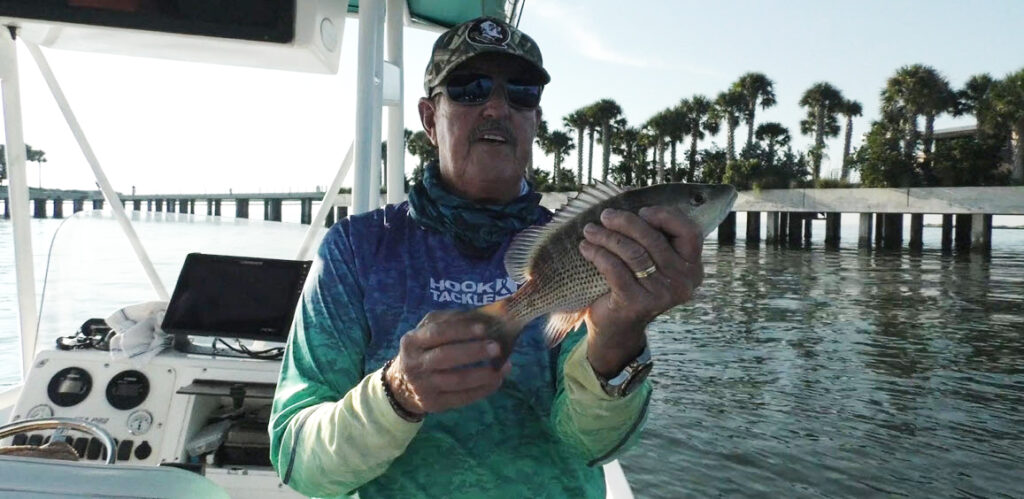
Captain Sergio holds a mangrove snapper with Tampa Bay’s iconic bridges and palm trees in the background.
Related Video: Fishing Adventures Florida Episode 19: Mangrove Snapper Madness
Fishing for Mangrove Snapper in Tampa Bay: The Angler’s Guide
In this comprehensive guide, we’ll dive into the art of fishing for mangrove snapper in Tampa Bay, offering expert advice to help you reel in these elusive fish. Tampa Bay is a fishing haven known for its rich marine biodiversity, and among the most coveted catches are the mangrove snappers. These stealthy fish provide a challenge for anglers of all levels, hiding in the shallow, rocky waters that skirt the bay’s mangrove forests.Understanding Mangrove Snapper Habitat
Shallow Waters: The Snapper’s Sanctuary
Mangrove snapper, also known as gray snapper, thrive in the warm, shallow waters of Tampa Bay. Ranging from bright reddish pink in color when juvenile to a more subdued gray as adults, these fish blend into their surroundings with ease. They prefer rocky structures like jetties, reefs, wrecks, and mangrove roots that provide ambush points to attack prey and refuge when threatened. Understanding what attracts snapper to these locales is key. Structures accumulate barnacles, tube worms, crabs, and shrimp that the snapper feed on voraciously. They also harbor small bait fish like pilchards, anchovies, and pinfish that seek the protection of the rocks. This abundance of food draws in large numbers of snapper. The shallow water around these structures further appeals to mangrove snapper. Water depths from 8-25 feet are ideal, allowing the sunny conditions they prefer while offering refuge if danger approaches from above in the form of birds, dolphin, or prowling anglers.When to Target Shallow Structures
Focus your efforts on shallow water structures during warmer periods from March through November. Water temperatures above 68 degrees prompt snapper to move shallower from offshore sites. Key in on periods around the new and full moons, when feeding activity intensifies.Gear and Bait: Preparing for Success
The Right Tackle to use when fishing for Mangrove Snapper in Tampa Bay
Tampa Bay’s mangrove snapper habitat poses challenges for tackle and terminal gear. Barnacle encrusted rocks and oyster beds abound, making strong line a necessity. Braided line in the 30-50 pound class resists this abrasion well. Flatten the line with pliers to reduce visibility. Pair braid with 2-4 foot sections of 20-30 pound fluorocarbon leader. The low visibility leader helps draw more strikes. Fluorocarbon also provides needed stiffness to prevent bite-offs on sharp gill rakers. Rods in the 7-7’6” range with a medium power fast action are perfect for casting artificial lures and live baits. Match with 3000-5000 size spinning reels with smooth, reliable drags set slightly loose. Terminal Gear for Bottom Fishing Success When bottom fishing natural baits and jigs, use non-offset circle hooks from size 1/0-3/0 for good hook sets in the corner of the mouth. Egg sinkers from 1⁄2-2 ounces get baits down quick and hold bottom in currents. Use lighter wire leaders if needed for mackerel or barracuda. For jigs, stick with 1⁄4 and 3/8 ounce leadheads for better control along rocky bottoms.Bait Selection: What Snappers Can’t Resist
- While artificial lures work at times, live and fresh dead baits are the best producers. Mangrove snapper feed on a variety of small crustaceans and baitfish. Prime baits include:
- Live Shrimp – Hook through the horn with a 1/0 live bait hook. Fish them on the bottom or under a cork for best action.
- Small Pilchards – The most abundant forage, pilchards 3-5” long are easy to catch via cast net and deadly on snapper when fished live.
- Pinfish – Lively pinfish 4-8” in length are prime snapper candy. Hook through the nose or body on a 2/0 circle hook with enough weight to reach bottom.
- Cut Bait – Fresh cut mackerel, threadfin, bluefish, or bonito entice big snapper when chummed. Cut bait in 1” chunks on a 2/0 circle hook.
Techniques and Strategies
Mastering the Cast: Tips for Precision and Stealth- Many strikes occur within seconds of the bait landing near structure. Precision and stealth are key.
- Use braided line and tie direct to avoid the noise of clipping on metal lures. Braid cuts through wind better for accuracy. Backlashes are also minimized.
- Release line smoothly on forward casts lifting the rod gently at the end to prevent bait splashing down noisily. Practice hitting specific targets consistently.
- Aim casts just past structure, allowing the bait to sink naturally back to hidey holes in the rocks. Mangroves dash out to inhale prey trying to escape.
Conservation and Regulations
Fishing Responsibly: Ensuring Future Generations
As a popular sport and table fish, mangrove snapper are heavily targeted in Tampa Bay, so following regulations is paramount:- 10” minimum size limit
- Possession limit – 10 fish per person
- Closed season Gulf waters Jan-March